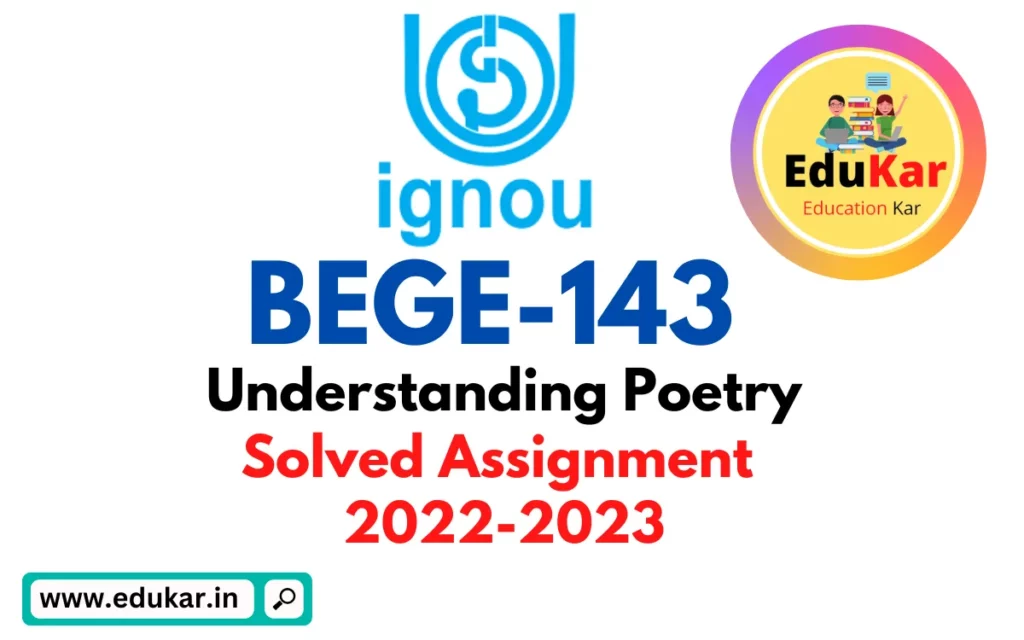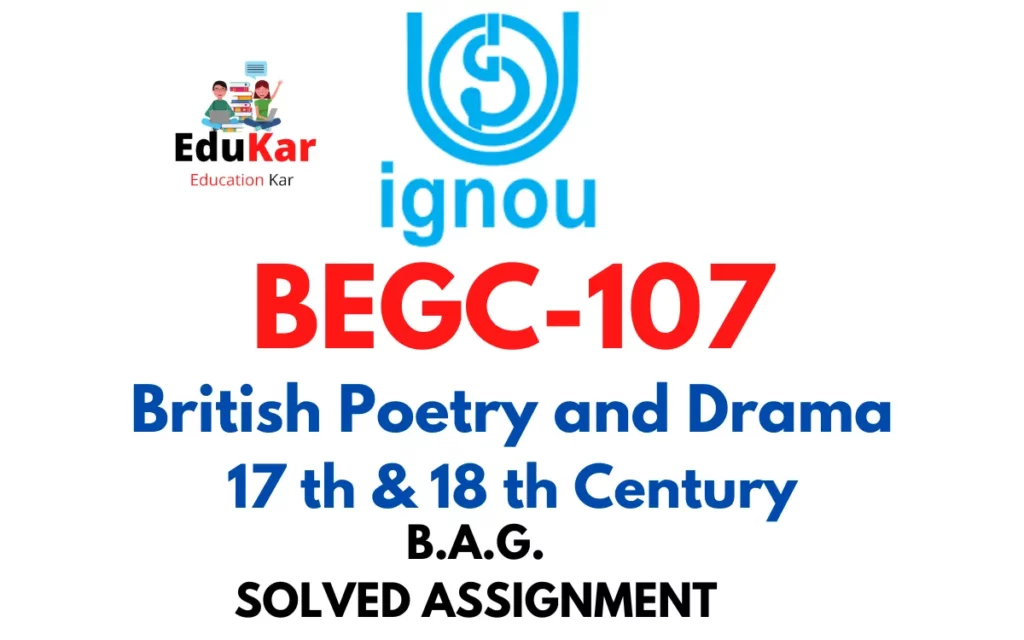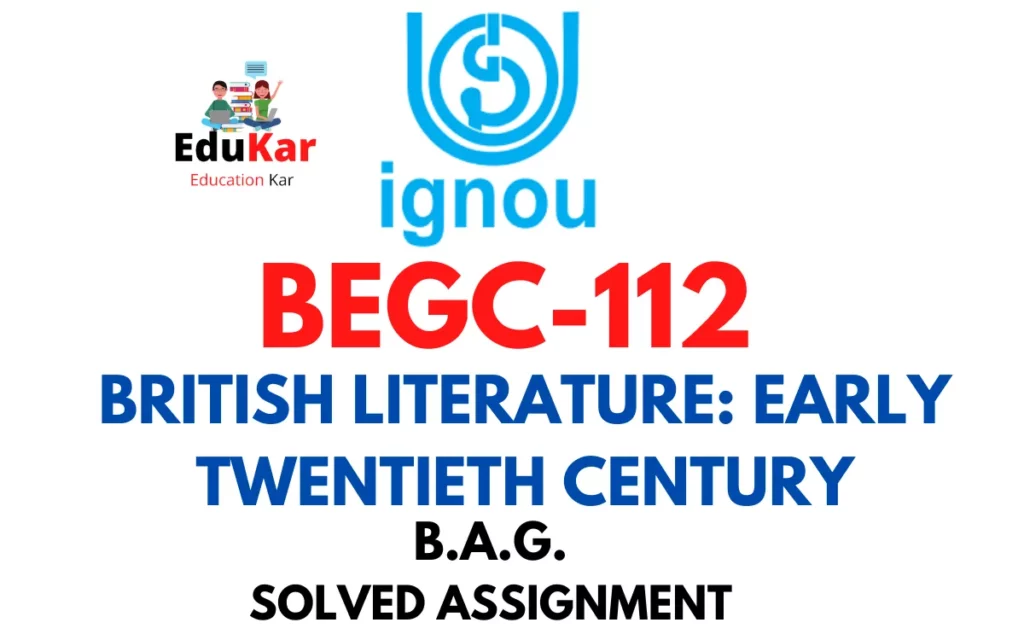Contents
- 1 SECTION-A
- 2 Explain the following with reference to the context:
- 3 1. I wonder if it hurts to live –And if They have to try –And whether – could They choose between –It would not be – to die –
- 4 2. The language I speakBecomes mine, its distortions, its queernessAll mine, mine alone. It is half English, halfIndian, funny perhaps, but it is honest,It is as human as I am human, don’tYou see?
- 5 3. You need no book, Rasha Sundarino paper or pen eitheryou have the black, smudgy kitchen wallfor your magical scribbleslines, ellipses, curvesall of them your secret codes fora whole new world.
- 6 4. When some day in distant parts she dwellsWhere what the people be like! I know not,Will they awaken her on gentle, mellow sounds?Or, will they, I misgive, snatch her sleep away?
- 7 SECTION-B
- 8 5. What are the issues that Mary Wollstonecraft touches upon?
- 9 6. Comment on the changed perspective in Chandrabhati’s Ramayana.
- 10 7. How does Ambai critique patriarchy in her story?
- 11 8. Can The Yellow Wallpaper be described as self-confessional literature?Elaborate.
- 12 SECTION-C
- 13 9. How does Sunlight on a Broken Column reflect the society of that time and place?
- 14 10. What do you think women’s writing seeks to express?
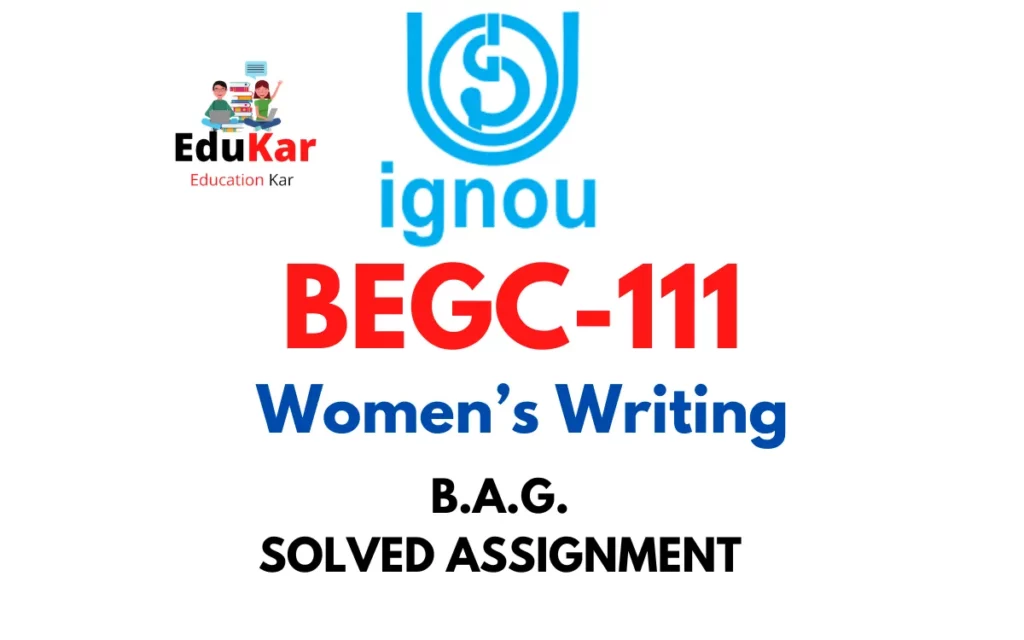
| Title | BEGC-111: IGNOU BAG Solved Assignment 2022-2023 |
| University | IGNOU |
| Degree | Bachelor Degree Programme |
| Course Code | BEGC-111 |
| Course Name | Women’s Writing |
| Programme Name | Bachelor of Arts (General) |
| Programme Code | BAG |
| Total Marks | 100 |
| Year | 2022-2023 |
| Language | English |
| Last Date for Submission of Assignment: | For June Examination: 31st April For December Examination: 30th September |
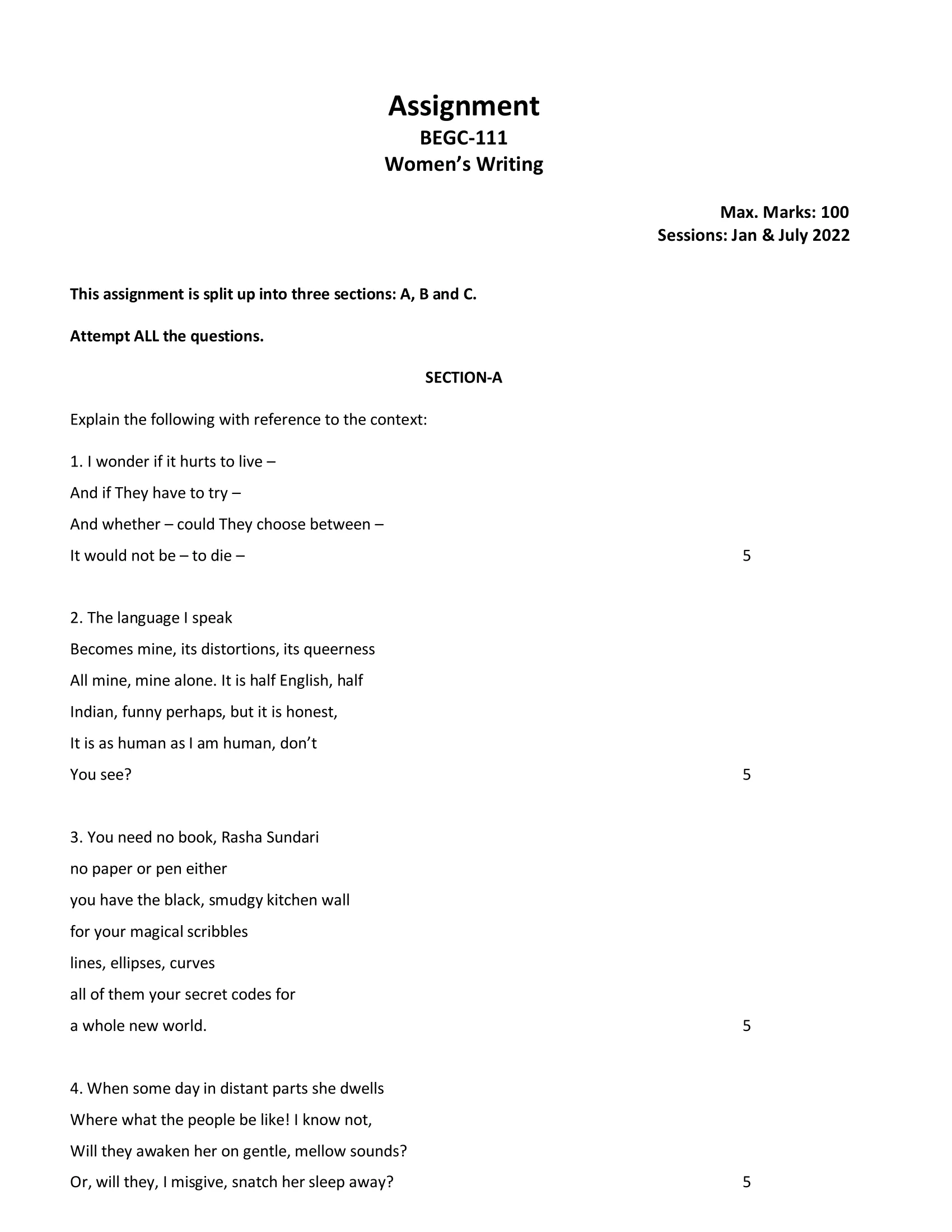
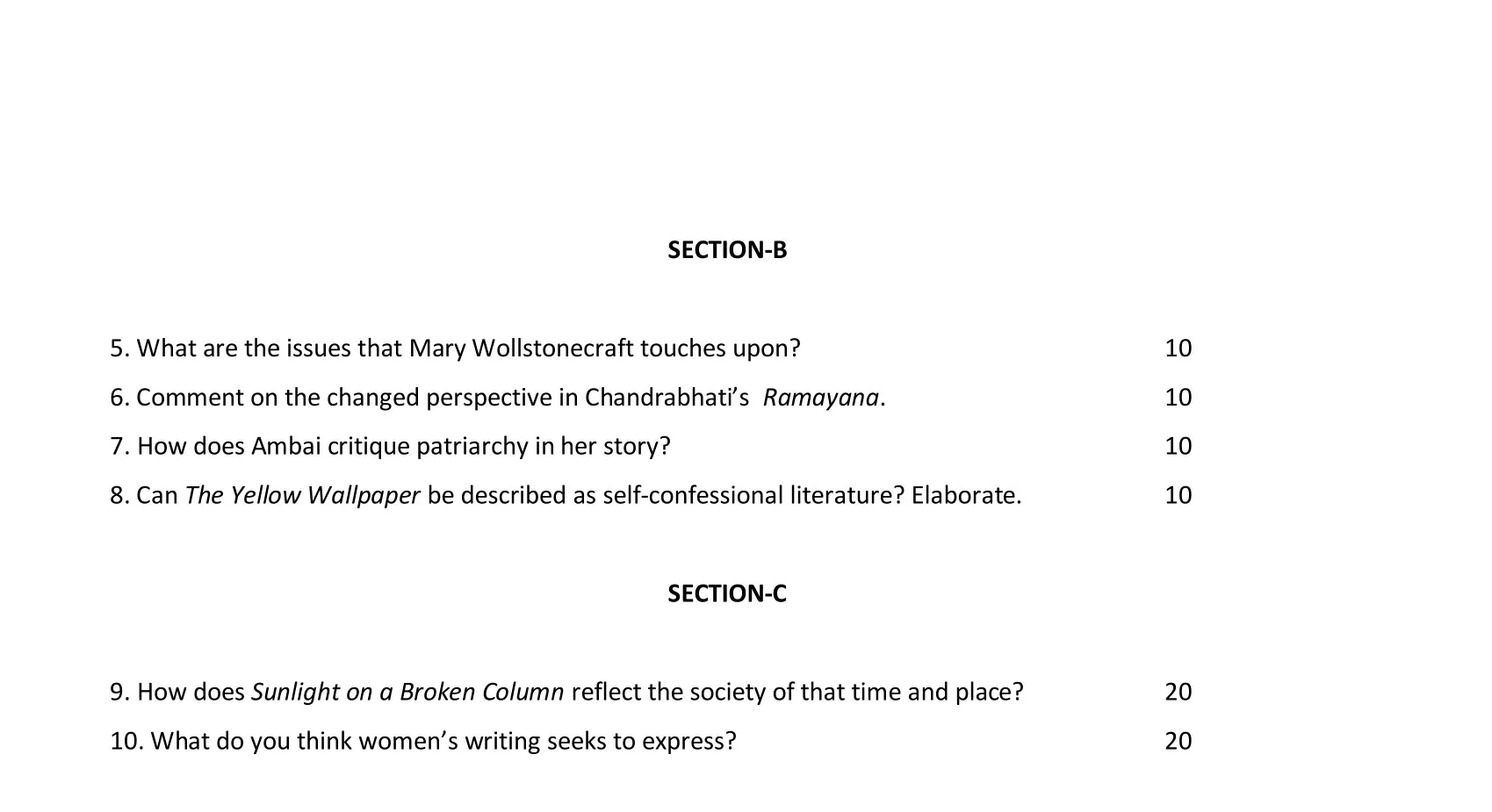
SECTION-A
Explain the following with reference to the context:
1. I wonder if it hurts to live –
And if They have to try –
And whether – could They choose between –
It would not be – to die –
Ans: The lines are from the poem “I’m Nobody! Who are you?” by Emily Dickinson.
In the context of the poem, the speaker is questioning the nature of existence and whether it is painful to live. They are also considering whether the forces that control life, represented as “They,” have to make an effort to keep life going. The speaker wonders if “They” have a choice between living and dying, and suggests that perhaps it would be easier to choose death than to continue living in pain.
Overall, the lines convey a sense of existential uncertainty and a desire for understanding the nature of life and death. The poem as a whole deals with the theme of identity and the feeling of being an outsider or a “nobody” in society.
2. The language I speak
Becomes mine, its distortions, its queerness
All mine, mine alone. It is half English, half
Indian, funny perhaps, but it is honest,
It is as human as I am human, don’t
You see?
Ans: The lines are from the poem “An Introduction” by Kamala Das, an Indian poet and writer who wrote in English.
In the context of the poem, the speaker is reflecting on her experience of growing up as an Indian who speaks English. She acknowledges that her language, which is a mixture of English and Indian, may be perceived as “funny” or distorted, but she also asserts that it is an honest representation of herself. She emphasizes that her language is “as human as I am human,” suggesting that her identity is closely tied to the way she speaks.
Overall, the lines convey a sense of pride in one’s cultural identity, even when it may be seen as unconventional or unconventional. The poem as a whole deals with themes of identity, language, and the struggle to assert one’s voice in a society that may not always value or understand it.
3. You need no book, Rasha Sundari
no paper or pen either
you have the black, smudgy kitchen wall
for your magical scribbles
lines, ellipses, curves
all of them your secret codes for
a whole new world.
Ans: The lines are from the poem “Rasha Sundari” by Taslima Nasrin, a Bangladeshi writer and activist.
In the context of the poem, the speaker is addressing Rasha Sundari, a young girl who is able to create her own magical world without the need for books, paper, or pens. The speaker highlights the girl’s creativity and resourcefulness, emphasizing that she can use the black, smudgy kitchen wall to create her own secret codes and symbols. The lines suggest that imagination and creativity can flourish in any environment, even one that may not provide the traditional tools of learning.
Overall, the lines convey a sense of wonder and appreciation for the power of imagination, especially in the face of adversity. The poem as a whole deals with themes of identity, gender, and the struggle for self-expression in a society that may seek to limit or silence it.
4. When some day in distant parts she dwells
Where what the people be like! I know not,
Will they awaken her on gentle, mellow sounds?
Or, will they, I misgive, snatch her sleep away?
Ans: The lines are from the poem “To My Sister” by William Wordsworth.
In the context of the poem, the speaker is addressing his younger sister, who is leaving home to go to a far-off place. The speaker expresses his concern for his sister’s well-being and wonders what the people in the new place will be like. He imagines that they may wake her up gently with “mellow sounds,” suggesting a peaceful and comforting environment. However, he also worries that they may “snatch her sleep away,” implying that the new place may be harsh or unpleasant.
Overall, the lines convey a sense of apprehension and uncertainty in the face of change and separation. The poem as a whole deals with themes of family, memory, and the passage of time.
SECTION-B
5. What are the issues that Mary Wollstonecraft touches upon?
Ans: Mary Wollstonecraft was an 18th-century writer and philosopher who is widely regarded as one of the pioneers of feminist thought. She wrote on a variety of topics, but some of the main issues that she touched upon include:
- Women’s rights and education: Wollstonecraft argued that women should have the same rights and opportunities as men, including access to education. She believed that women’s lack of education and opportunities were responsible for their oppression and subordination in society.
- Gender equality: Wollstonecraft believed that men and women were equal and that gender distinctions were arbitrary and harmful. She criticized the traditional gender roles that assigned men as active and rational, while women were relegated to passive and emotional roles.
- Marriage and family: Wollstonecraft argued that marriage should be based on mutual respect and affection rather than financial or social considerations. She also criticized the traditional family structure and argued that parents should raise their children as individuals with their own rights and needs.
- Political reform: Wollstonecraft was an advocate of political reform and democracy. She believed that all individuals, including women, should have a say in the political process and that government should be based on reason and justice.
- Religious tolerance: Wollstonecraft was a proponent of religious tolerance and believed that individuals should be free to choose their own beliefs and practice their own religion without fear of persecution.
6. Comment on the changed perspective in Chandrabhati’s Ramayana.
Ans: Chandrabhati’s Ramayana is a medieval retelling of the story of Rama, one of the most popular and influential tales in Indian mythology. Compared to the original Valmiki Ramayana and other retellings, Chandrabhati’s Ramayana is notable for its changed perspective on certain key characters and events in the story.
One of the most significant changes in Chandrabhati’s Ramayana is the portrayal of Ravana, the demon king who kidnaps Rama’s wife Sita. In the Valmiki Ramayana and most other retellings, Ravana is depicted as a wicked and evil character who is the personification of evil. In Chandrabhati’s Ramayana, however, Ravana is portrayed more sympathetically. His virtues, including his knowledge of the Vedas, his devotion to Shiva, and his bravery, are highlighted, and his motives for abducting Sita are presented as being driven by a sense of injustice and vengeance.
Another significant change in Chandrabhati’s Ramayana is the portrayal of Sita. In the Valmiki Ramayana and other retellings, Sita is often seen as a passive victim, whose virtue and chastity are central to the story. In Chandrabhati’s Ramayana, Sita is given a more active role, and her character is portrayed as being strong-willed, independent, and resourceful. She is presented as a woman who is capable of taking her own decisions and who ultimately asserts her independence and autonomy by rejecting Rama’s offer to return to Ayodhya.
Overall, Chandrabhati’s Ramayana represents a significant departure from the traditional retellings of the story of Rama. By presenting a more nuanced and complex perspective on the characters and events in the story, Chandrabhati’s Ramayana challenges the simplistic binaries of good and evil that are often presented in the Valmiki Ramayana and other retellings, and offers a more nuanced and humanistic portrayal of the characters and their motivations.
7. How does Ambai critique patriarchy in her story?
Ans: Ambai is a contemporary Indian writer who is well-known for her feminist writings that critique patriarchy and its impact on women’s lives. In her short story “A Kitchen in the Corner of the House,” Ambai presents a powerful critique of patriarchy and its effects on women’s lives and relationships.
One of the primary ways in which Ambai critiques patriarchy in her story is by showing how it imposes rigid gender roles and stereotypes on women, which restricts their freedom and agency. The women in the story are all confined to the domestic sphere, where they are expected to serve and care for their families, and are discouraged from pursuing their own interests and desires. This is exemplified by the narrator’s mother, who is denied the opportunity to pursue her love for classical music because of her gender.
Ambai also critiques the ways in which patriarchy affects women’s relationships with each other. In the story, the women are portrayed as being in competition with each other, with the narrator’s mother competing with her sister-in-law for her husband’s affections. This competition is fueled by the patriarchal system, which places women in a subordinate position and creates a culture of suspicion and mistrust among them.
Furthermore, Ambai also highlights how patriarchy leads to the objectification and commodification of women’s bodies. The narrator’s aunt is forced into a marriage with a much older man, and her body is described as being “sold off” to him as part of the marriage contract.
8. Can The Yellow Wallpaper be described as self-confessional literature?Elaborate.
Ans: “The Yellow Wallpaper” is a short story by Charlotte Perkins Gilman, first published in 1892. The story is written in the form of a first-person narrative, with the protagonist, a woman suffering from mental illness, describing her experiences and feelings. The story is often read as a critique of the patriarchal medical establishment of the time, which treated mental illness with confinement and isolation.
While “The Yellow Wallpaper” can be read as a work of self-confessional literature, it is important to note that it is a fictionalized account of the author’s own experiences. Like the protagonist of the story, Gilman suffered from depression and was prescribed a “rest cure” by her doctor, which included confinement to her bedroom and restrictions on her activities. However, the story is not a straightforward retelling of Gilman’s own experiences, but rather a fictionalized account that draws on her personal experiences to make a broader critique of the medical establishment and its treatment of women.
That being said, the story does contain many elements of self-confessional literature. The first-person narrative, which is told from the perspective of the protagonist, creates a sense of intimacy and immediacy, allowing the reader to experience the protagonist’s thoughts and emotions firsthand. The story also contains many details that suggest a close connection between the protagonist and the author, such as the protagonist’s background as a writer and her interest in social reform.
Overall, while “The Yellow Wallpaper” is not strictly a work of self-confessional literature, it does contain many elements of the genre. The story draws on the author’s personal experiences to create a powerful critique of the medical establishment and its treatment of women, and the first-person narrative creates a sense of intimacy and immediacy that is characteristic of self-confessional literature.
SECTION-C
9. How does Sunlight on a Broken Column reflect the society of that time and place?
Ans: Sunlight on a Broken Column is a novel by Attia Hosain set in pre-partition India in the early 20th century, and it provides a vivid portrait of the Muslim aristocracy in Lucknow. The novel reflects the society of that time and place in several ways:
- Social hierarchy: The novel reflects the social hierarchy that was prevalent in the Muslim aristocracy of Lucknow at that time. The characters are divided into different social classes based on their wealth, education, and occupation, and the social customs and traditions are strictly adhered to by the characters. The novel portrays the societal norms and values of the time, such as the restrictions placed on women’s education and the strict codes of conduct expected of them.
- Religious identity: The novel also reflects the religious identity of the Muslim community in pre-partition India. The characters are depicted as being very religious and adhering to Islamic traditions and customs. The novel also shows the interplay of religion and politics in that era, as many characters are shown to be involved in political activities and discussions, often in the context of the larger Muslim community in India.
- Colonialism and nationalism: The novel reflects the impact of colonialism on the Indian society of that time, particularly in the characters’ attitudes towards the British rulers. The novel also shows the emergence of nationalism and political awareness among the characters, particularly the younger generation, who are shown to be interested in the political developments of the time and the nationalist movement that was gaining momentum.
10. What do you think women’s writing seeks to express?
Ans: Women’s writing seeks to express a range of experiences and perspectives that are unique to women. Historically, women’s voices and perspectives have been marginalized or excluded from mainstream literature, and women’s writing seeks to challenge this exclusion and provide a platform for women to express themselves.
Women’s writing often explores themes such as gender, identity, relationships, power dynamics, and the lived experiences of women in society. It may also seek to subvert or challenge traditional gender roles and societal norms, or to highlight the ways in which women are impacted by sexism, misogyny, and other forms of oppression.
In addition, women’s writing often emphasizes the importance of women’s individual experiences and perspectives. It may focus on the stories of women who have been historically overlooked or silenced, or on the experiences of women from different backgrounds and cultures.
Overall, women’s writing seeks to provide a diverse and multifaceted perspective on the world, one that is shaped by the experiences and perspectives of women. It seeks to challenge and subvert dominant narratives and to provide a platform for women’s voices to be heard and valued.
How to Download BEGC-111 Solved Assignment?
You can download it from the www.edukar.in, they have a big database for all the IGNOU solved assignments.
Is the BEGC-111 Solved Assignment Free?
Yes this is absolutely free to download the solved assignment from www.edukar.in
What is the last submission date for BEGC-111 Solved Assignment?
For June Examination: 31st April, For December Examination: 30th October



